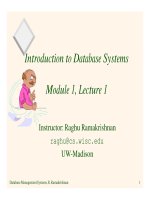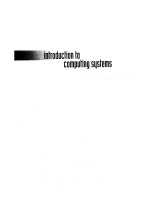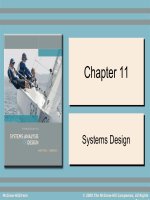Lecture Introduction to computing systems (2/e): Chapter 4 - Yale N. Patt, Sanjay J. Patel
Bạn đang xem bản rút gọn của tài liệu. Xem và tải ngay bản đầy đủ của tài liệu tại đây (349.78 KB, 24 trang )
Chapter 4
The Von Neumann
Model
Copyright © The McGraw-Hill Companies, Inc. Permission required for reproduction or display.
The Stored Program Computer
1943: ENIAC
• Presper Eckert and John Mauchly -- first general electronic computer.
(or was it John V. Atananasoff in 1939?)
• Hard-wired program -- settings of dials and switches.
1944: Beginnings of EDVAC
• among other improvements, includes program stored in memory
1945: John von Neumann
• wrote a report on the stored program concept,
known as the First Draft of a Report on EDVAC
The basic structure proposed in the draft became known
as the “von Neumann machine” (or model).
• a memory, containing instructions and data
• a processing unit, for performing arithmetic and logical operations
• a control unit, for interpreting instructions
For more history, see />
42
Copyright © The McGraw-Hill Companies, Inc. Permission required for reproduction or display.
Von Neumann Model
M EM ORY
M AR
M DR
IN P U T
O UTPU T
K e yb o a rd
M ouse
Scanner
D is k
M o n ito r
P rin te r
LED
D is k
P R O C E S S IN G U N IT
ALU
TEM P
C O N T R O L U N IT
PC
IR
43
Copyright © The McGraw-Hill Companies, Inc. Permission required for reproduction or display.
Memory
k x m array of stored bits (k is usually 2n)
Address
• unique (n-bit) identifier of location
Contents
• m-bit value stored in location
Basic Operations:
LOAD
• read a value from a memory location
0000
0001
0010
0011
0100
0101
0110
1101
1110
1111
STORE
• write a value to a memory location
44
00101101
•
•
•
10100010
Copyright © The McGraw-Hill Companies, Inc. Permission required for reproduction or display.
Interface to Memory
How does processing unit get data to/from memory?
MAR: Memory Address Register
M EM ORY
MDR: Memory Data Register
M AR
M DR
To read a location (A):
1. Write the address (A) into the MAR.
2. Send a “read” signal to the memory.
3. Read the data from MDR.
To write a value (X) to a location (A):
1. Write the data (X) to the MDR.
2. Write the address (A) into the MAR.
3. Send a “write” signal to the memory.
45
Copyright © The McGraw-Hill Companies, Inc. Permission required for reproduction or display.
Processing Unit
Functional Units
• ALU = Arithmetic and Logic Unit
• could have many functional units.
some of them special-purpose
(multiply, square root, …)
• LC-2 performs ADD, AND, NOT
P R O C E S S IN G U N IT
TEM P
ALU
Registers
• Small, temporary storage
• Operands and results of functional units
• LC-2 has eight register (R0, …, R7)
Word Size
• number of bits normally processed by ALU in one instruction
• also width of registers
• LC-2 is 16 bits
46
Copyright © The McGraw-Hill Companies, Inc. Permission required for reproduction or display.
Input and Output
Devices for getting data into and out of computer
memory
Each device has its own interface,
usually a set of registers like the
memory’s MAR and MDR
IN P U T
O UTPU T
K e yb o a rd
M ou se
Scanner
D is k
M o n ito r
P rin te r
LED
D is k
• LC-2 supports keyboard (input) and console (output)
• keyboard: data register (KBDR) and status register (KBSR)
• console: data register (CRTDR) and status register (CRTSR)
Some devices provide both input and output
• disk, network
Program that controls access to a device is
usually called a driver.
47
Copyright © The McGraw-Hill Companies, Inc. Permission required for reproduction or display.
Control Unit
Orchestrates execution of the program
C O N T R O L U N IT
PC
IR
Instruction Register (IR) contains the current instruction.
Program Counter (PC) contains the address
of the next instruction to be executed.
Control unit:
• reads an instruction from memory
the instruction’s address is in the PC
• interprets the instruction, generating signals
that tell the other components what to do
an instruction may take many machine cycles to complete
48
Copyright © The McGraw-Hill Companies, Inc. Permission required for reproduction or display.
Instruction Processing
Fetch instruction from memory
Decode instruction
Evaluate address
Fetch operands from memory
Execute operation
Store result
49
Copyright © The McGraw-Hill Companies, Inc. Permission required for reproduction or display.
Instruction
The instruction is the fundamental unit of work.
Specifies two things:
• opcode: operation to be performed
• operands: data/locations to be used for operation
An instruction is encoded as a sequence of bits.
(Just like data!)
• Often, but not always, instructions have a fixed length,
such as 16 or 32 bits.
• Control unit interprets instruction:
generates sequence of control signals to carry out operation.
• Operation is either executed completely, or not at all.
A computer’s instructions and their formats is known as its
Instruction Set Architecture (ISA).
410
Copyright © The McGraw-Hill Companies, Inc. Permission required for reproduction or display.
Example: LC-2 ADD Instruction
LC-2 has 16-bit instructions.
• Each instruction has a four-bit opcode, bits [15:12].
LC-2 has eight registers (R0-R7) for temporary storage.
• Sources and destination of ADD are registers.
“Add the contents of R2 to the contents of R6,
and store the result in R6.”
411
Copyright © The McGraw-Hill Companies, Inc. Permission required for reproduction or display.
Example: LC-2 LDR Instruction
Load instruction -- reads data from memory
Base + offset mode:
• add offset to base register -- result is memory address
• load from memory address into destination register
“Add the value 6 to the contents of R3 to form a
memory address. Load the contents stored in
that address to R2.”
412
Copyright © The McGraw-Hill Companies, Inc. Permission required for reproduction or display.
Instruction Processing: FETCH
Load next instruction (at address stored in PC)
from memory
into Instruction Register (IR).
• Load contents of PC into MAR.
• Send “read” signal to memory.
• Read contents of MDR, store in IR.
F
D
EA
Then increment PC, so that it points to
the next instruction in sequence.
OP
• PC becomes PC+1.
EX
S
413
Copyright © The McGraw-Hill Companies, Inc. Permission required for reproduction or display.
Instruction Processing: DECODE
First identify the opcode.
• In LC-2, this is always the first four bits of instruction.
• A 4-to-16 decoder asserts a control line corresponding
to the desired opcode.
F
D
Depending on opcode, identify other operands
from the remaining bits.
EA
• Example:
for LDR, last six bits is offset
for ADD, last three bits is source operand #2
OP
EX
S
414
Copyright © The McGraw-Hill Companies, Inc. Permission required for reproduction or display.
Instruction Processing: EVALUATE ADDRESS
For instructions that require memory access,
compute address used for access.
F
Examples:
D
• add offset to base register (as in LDR)
• add offset to PC (or to part of PC)
• add offset to zero
EA
OP
EX
S
415
Copyright © The McGraw-Hill Companies, Inc. Permission required for reproduction or display.
Instruction Processing: FETCH OPERANDS
Obtain source operands needed to
perform operation.
F
Examples:
D
• load data from memory (LDR)
• read data from register file (ADD)
EA
OP
EX
S
416
Copyright © The McGraw-Hill Companies, Inc. Permission required for reproduction or display.
Instruction Processing: EXECUTE
Perform the operation,
using the source operands.
F
Examples:
D
• send operands to ALU and assert ADD signal
• do nothing (e.g., for loads and stores)
EA
OP
EX
S
417
Copyright © The McGraw-Hill Companies, Inc. Permission required for reproduction or display.
Instruction Processing: STORE
Write results to destination.
(register or memory)
F
Examples:
D
• result of ADD is placed in destination register
• result of memory load is placed in destination register
• for store instruction, data is stored to memory
write address to MAR, data to MDR
assert WRITE signal to memory
EA
OP
EX
S
418
Copyright © The McGraw-Hill Companies, Inc. Permission required for reproduction or display.
Changing the Sequence of Instructions
In the FETCH phase,
we incremented the Program Counter by 1.
What if we don’t want to always execute the instruction
that follows this one?
• examples: loop, if-then, function call
Need special instructions that change the contents
of the PC.
These are called jumps and branches.
• jumps are unconditional -- they always change the PC
• branches are conditional -- they change the PC only if
some condition is true (e.g., the contents of a register is zero)
419
Copyright © The McGraw-Hill Companies, Inc. Permission required for reproduction or display.
Example: LC-2 JMPR Instruction
Set the PC to the value obtained by adding an offset
to a register. This becomes the address of the next
instruction to fetch.
“Add the value of 6 to the contents of R3,
and load the result into the PC.”
420
Copyright © The McGraw-Hill Companies, Inc. Permission required for reproduction or display.
Instruction Processing Summary
Instructions look just like data -- it’s all interpretation.
Three basic kinds of instructions:
• computational instructions (ADD, AND, …)
• data movement instructions (LD, ST, …)
• control instructions (JMP, BRnz, …)
Six basic phases of instruction processing:
F
D
EA
OP
EX
S
• not all phases are needed by every instruction
• phases may take variable number of machine cycles
421
Copyright © The McGraw-Hill Companies, Inc. Permission required for reproduction or display.
Driving Force: The Clock
The clock is a signal that keeps the control unit moving.
• At each clock “tick,” control unit moves to the next
machine cycle -- may be next instruction or
next phase of current instruction.
Clock generator circuit:
• Based on crystal oscillator
• Generates regular sequence of “0” and “1” logic levels
• Clock cycle (or machine cycle) -- rising edge to rising edge
“1”
“0”
Machine
Cycle
time
422
Copyright © The McGraw-Hill Companies, Inc. Permission required for reproduction or display.
Instructions vs. Clock Cycles
MIPS vs. MHz
• MIPS = millions of instructions per second
• MHz = millions of clock cycles per second
These are not the same -- why?
423
Copyright © The McGraw-Hill Companies, Inc. Permission required for reproduction or display.
Stopping the Clock
Control unit will repeat instruction processing sequence
as long as clock is running.
• If not processing instructions from your application,
then it is processing instructions from the Operating System (OS).
• The OS is a special program that manages processor
and other resources.
To stop the computer:
• AND the clock generator signal with ZERO
• when control unit stops seeing the CLOCK signal, it stops processing
424









